Scabs After Hair Transplant: Yohann’s story
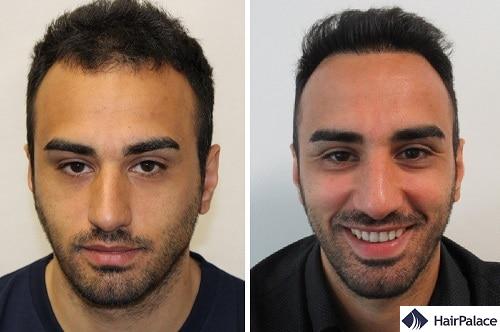
In this post, I will guide you through Yohann’s hair transplant and show you how he achieved the result you see above!
Before the surgery, it is essential to check each patient’s condition.
This way we can determine how many hairs we can work with, how many are needed for the desired result and create a personalized treatment plan.
Back in 2016 Yohann sent us his photos for an initial evaluation and to get an idea about how much the hair transplant would cost for him.
While he was interested in the offer, he postponed making a decision.
As the hair loss might progress, patients might be better off with more hairs or a different distribution later on.
Thus when Yohann got back in touch a year later, we had to check his condition again.
He met us on the 7th of December 2017.
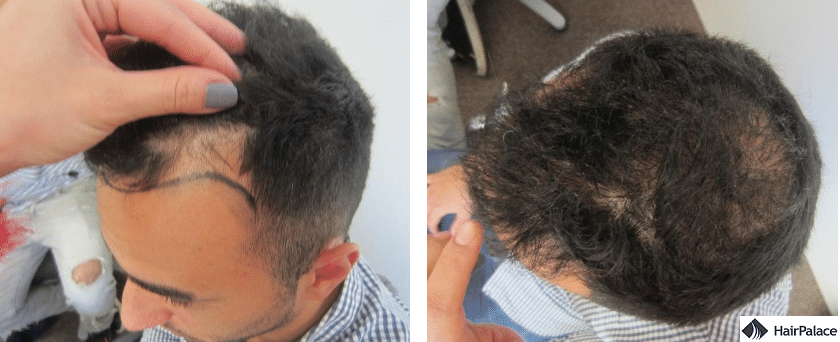
After examining his scalp and the donor area, the doctor discussed the areas Yohann wanted to cover.
He explained that he would prefer a slightly lower hairline and he was interested in some thickening done at the crown area too.
Overall, we found that with 5-6000 hairs it is possible to achieve Yohann’s goals in both areas.
- Yohann’s hair transplant
- 7 days after the surgery
- 3 weeks to 3 months after the surgery
- 6 months after the surgery
- 1 year after the surgery
Yohann’s hair transplant
Fast forward a few months, and we had Yohann and 2 of his friends here in Budapest for their surgeries.
(As we have 4 surgery rooms it is possible to carry out up to 4 surgeries simultaneously – with a different doctor and medical team of course.)
On the 7-8th of April 2018, Yohann had a total of 6036 hairs transplanted.
Per usual, his surgery was carried out with short hair.
As we work under a magnifying glass, this practice helps us see all hairs in and around the treated area, which in turn has several benefits:
- We can make sure not to damage the native hairs by implanting the new ones too close;
- We can match the angle of implantation to the rest of the hairs;
- The natural density is well visible, thus it is easier to recreate.
The picture below shows the final distribution in Yohann’s case.
We can see that I implanted the hairs with higher density at the front; as the bare areas at the triangles required more hairs for the good density.
In comparison, I could place the new hairs more sparsely at the crown, as it had higher existing density:
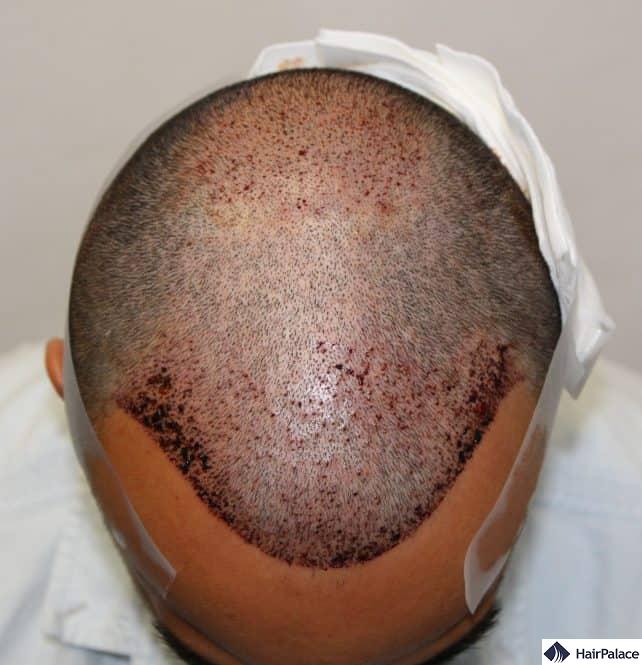
7 days after the surgery
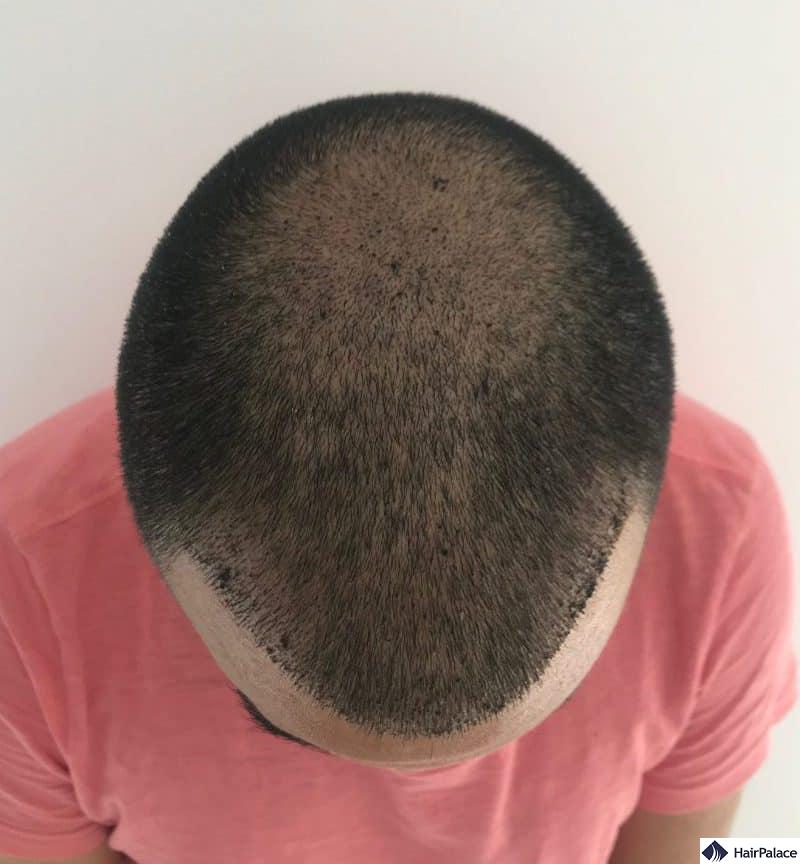
Yohann had his first checkup is a week after the surgery.
After closely inspecting his photos, I could confirm that all is well; as we can see above there is no inflammation, and the hairs are in place.
Naturally, as the surgery is still fresh you’ll see the hair transplant scabs not falling off and remaining visible.
As the tiny wounds underneath are closed up, it is okay to start soaking them off after the 1st post-op week.
First, you have to soak your head for about 15-20 minutes either in the bathtub or under the shower. Both method works, it is up to you which one you find more comfortable.
Using only lukewarm tap water is more important, without adding shampoo or any products.
After the scabs soften up completely, a gentle massage should be applied to help them fall off.
They must not be forced or scratched off – get off only as many as you can effortlessly. Then you can rinse the scalp and let it dry.
This process must be repeated daily during the 2nd post-op week to soak the rest of the scabs off.
From the 3rd post-op week, it will be okay to start using baby shampoo to massage gently through the scalp.
Baby shampoo is not only gentle enough, but it is also hydrating which can help if the saline solution and removing the scabs cause some flakiness.
Hair transplant scabs after 3 weeks to 3 months
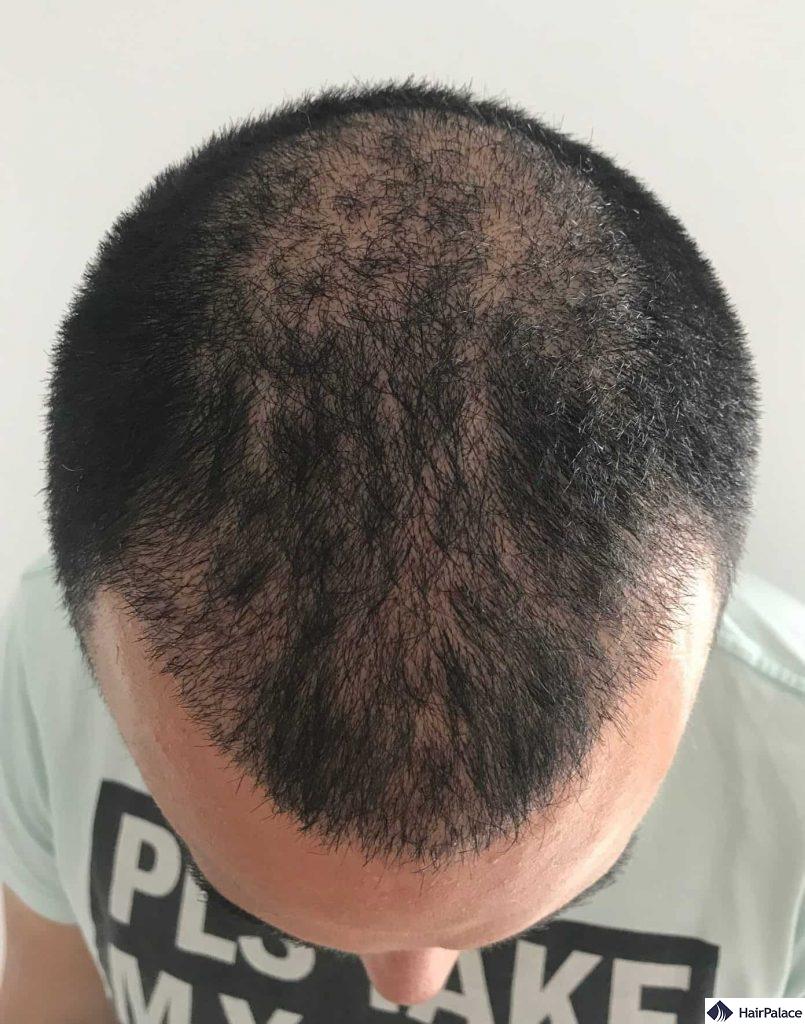
Yohann’s next checkup was 3 weeks after his hair transplant.
I was happy to see that the hair transplant scabs are gone and his scalp is in good condition.
As we can see in the picture above, there are no recent, small wounds which told me that he was careful enough during the previous weeks.
The implanted hairs are also in place – empty patches would have indicated that he did not soak the scabs thoroughly before the massage, or that he massaged the scalp too harshly.
Around the end of the 3rd week, the implanted hairs start to shed.
After the transplant, the implanted roots enter a dormant period, and the hair strands fall out gradually.
Though it is not easy to see, by the end of the 3rd post-op month the condition returns to the pre-surgery stage.
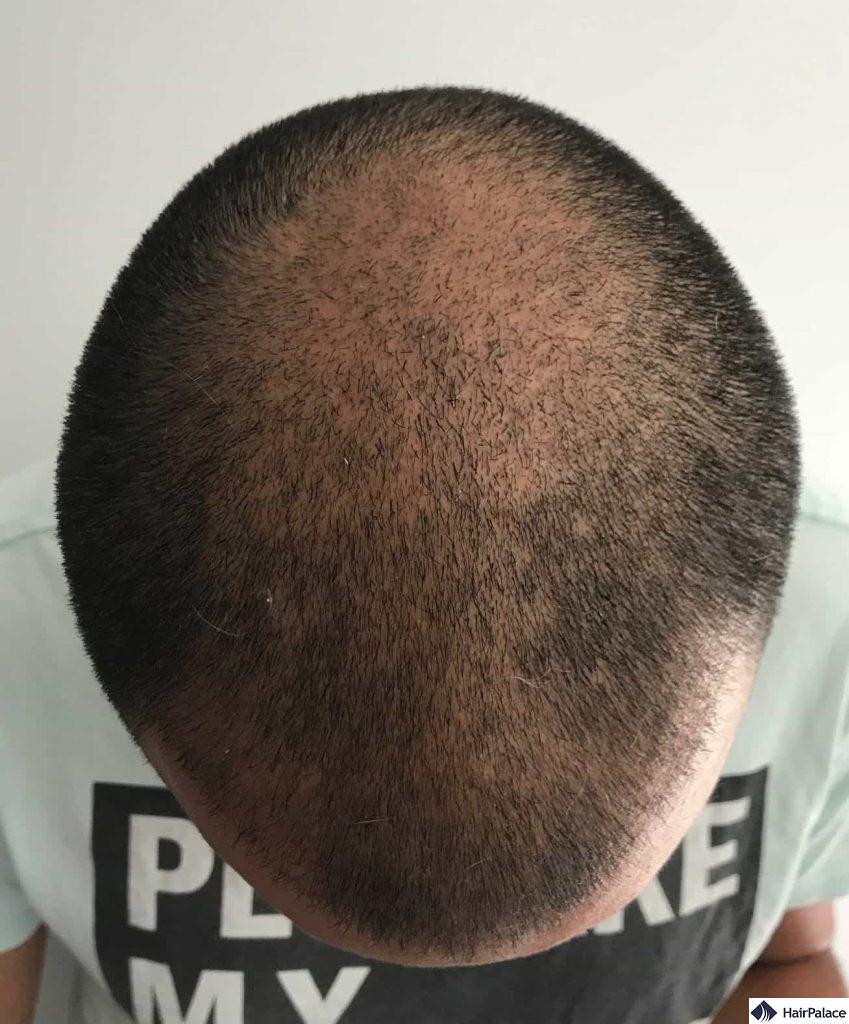
At Yohann’s 3 months check-up, I could see that he went through this process too.
As we see in the photo above, his scalp is clean and healthy, as it should be.
Some patients with more sensitive skin might experience some spots here and there, but that would be all right in this period.
6 months after the surgery
After the transplanted hairs fall out, the density starts to increase around the 4th post-op month.
Usually, there is a sudden change, as a large number of hairs grow out in just 3 months.
By the end of the 6th post-op month, about half of the result is visible.
In Yohann’s case, this partial result was decent already.
The density started to even out, and we can see a more pronounced hairline on his checkup photo below:
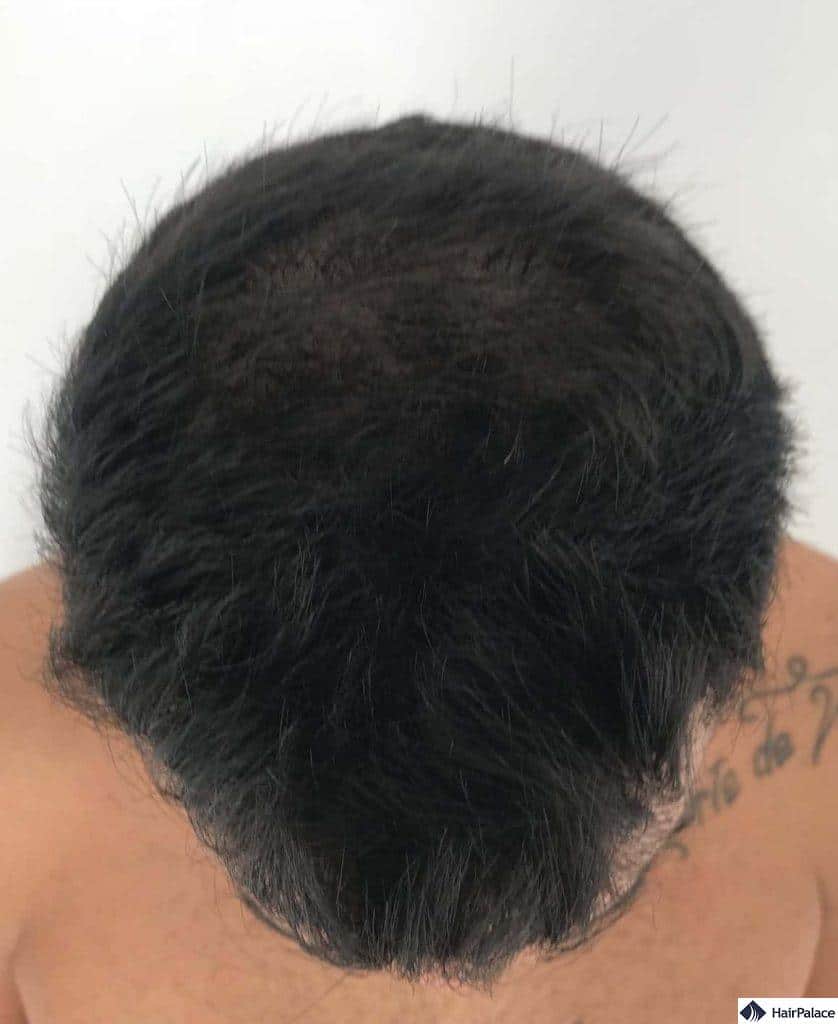
1 year after the surgery
The rest of the new hairs continue to grow out in the next couple of months.
The result is usually visible 12 months after the surgery; this is when we have the final check-up.
We met Yohann again to examine the result of his hair transplant, and I revised the photos too.
Upon the examination we found a great result – the hairs have grown out in great numbers, providing a natural look.
And more importantly, Yohann was also completely satisfied with the outcome:
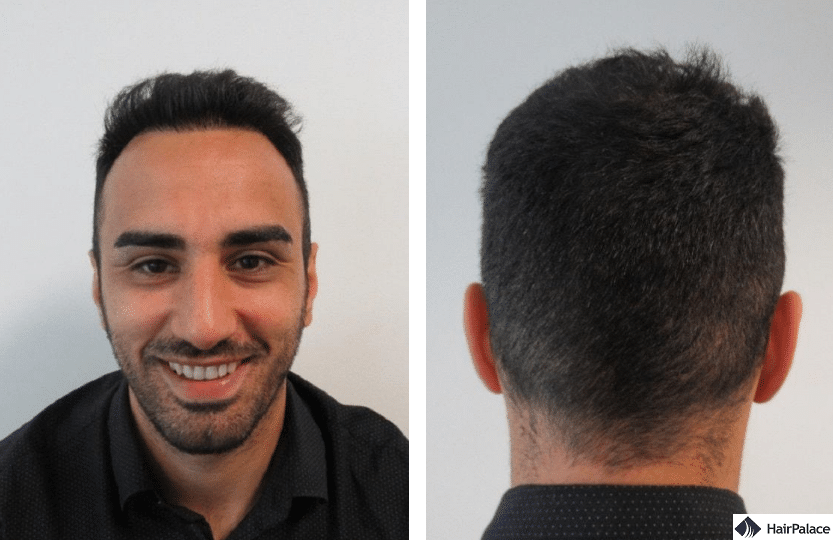
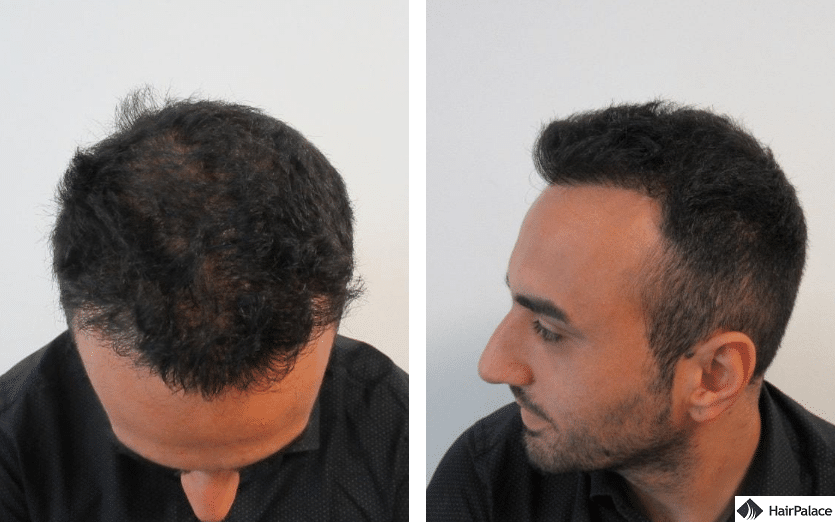
FAQ
To remove scabs after a hair transplant, gently wash your scalp with a mild shampoo after waiting for the period recommended by your surgeon (usually 7-10 days). Use light circular motions with your fingertips to soften and dislodge the scabs. Do not pick or scratch at the scabs, as this can damage the hair follicles. Follow your surgeon’s specific instructions for the best care and results.
Scabs after a hair transplant typically last for 7 to 14 days.
Scabs usually start to fall off 2 to 3 weeks after a hair transplant.
Last medically reviewed on August 2nd, 2024


